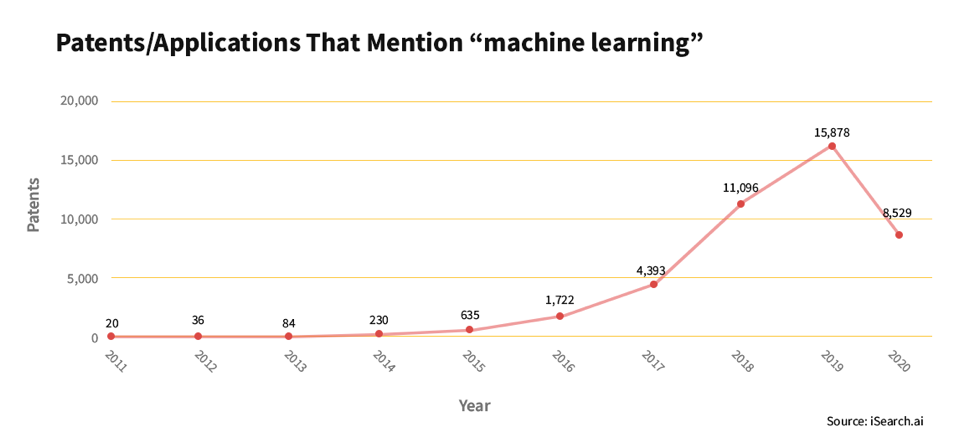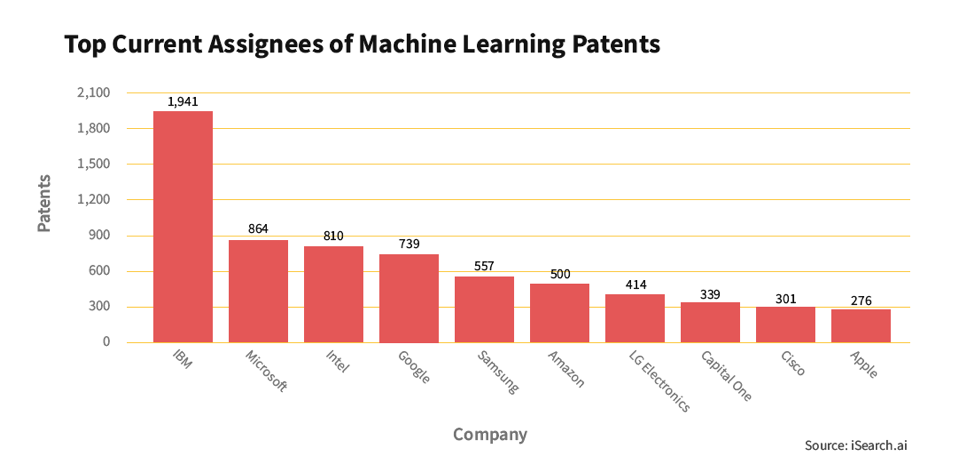“To modernize our patent infrastructure, we need better tools to help inventors and examiners find relevant prior art.”
 Patent categories were established more than 100 years ago. There are dozens of categories that reflect industry at the time: gears, sewing machines, and bicycles, to name a few.
Patent categories were established more than 100 years ago. There are dozens of categories that reflect industry at the time: gears, sewing machines, and bicycles, to name a few.
While these are certainly useful categories, the patent classification system has not kept up with the times. It leaves out many modern technologies, like inventions that are based on machine learning or blockchain. There are no categories for these innovations, which are reshaping our world in real-time.
The problem? When patent classifications don’t actually classify inventions, we have no way of knowing how many inventions in these categories are being registered.
Even if there are no specific categories for them, they can still be protected with a patent. This makes it difficult for innovators to be sure their ideas are patentable because it’s not always clear in which category to search.
This problem is particularly acute in machine learning, which is an especially “hot” sector with many competing patents that may or may not be classified correctly. Let’s look at the data—and propose a solution.
The Murky Patent Waters
If you read reports related to machine learning patents, you’ll find unclear information that can be misleading.
For instance, one patent data analytics platform recently analyzed published U.S. patent applications to find that machine learning patents were ranked at #4 in 2020. They considered machine learning patents to be only those in the patent class G06N 20, with an asterisk: “group G06N 20/00 is impacted by reclassification into groups G06N 20/10 and G06N 20/20.”
The warning adds: “All groups listed in this warning should be considered in order to perform a complete search.” Each of these groups includes machine learning patents, and an incomplete analysis can’t be conclusive.
Doing our own research, we found out these are the top current assignees of machine learning patents in the G06N 20 class:

We see familiar companies like IBM, Microsoft, and Google, but some notable names are absent, such as Apple and Amazon.
So, what happens if we expand our analysis to see if this classification was missing some patents or patent holders? We’re confident that the current patent classifications are no longer fit for purpose, so we decided to do some sleuthing.
Looking Elsewhere for Machine Learning Patents
We did a simple keyword search to look for machine learning patents and applications that may not appear in the single classification.
We found 42,623 patents/applications that mention “machine learning” have been published since 2011. Of these, 8,529 were filed in 2020, or 18.3%. The overall filing year distribution is as follows:

Of these patents/applications mentioning “machine learning,” 33,121 aren’t part of the G06N 20 class. That’s 77.7%.
There’s a massive gap between the analysis based on the G06N 20 classification and the semantic search for mentions of machine learning. This discrepancy is the result of our outdated patent classification system that hasn’t caught up with the times.
And remember Apple’s notable absence from the earlier graphic? Well, it turns out that the company was actually active in machine learning in 2020: it filed 276 of the patents/applications outside of the G06N 20 class that mention “machine learning.”
Under these criteria, Apple is one of the top filers in the machine learning area. Of course, because the referenced study only considers one category, Apple is not even mentioned among the top patent assignees.
Looking a bit deeper into Apple’s patents, we can see that they have quite a few machine learning patents, but they aren’t in the G06N 20 class.

Clearly, Apple has been active in machine learning, and our broken classification system doesn’t allow competitors, the public, or the media to easily track which patents are filed under which category. This glaring discrepancy is just one of the reasons why we need to reform our patent classification system.
Rebooting Our Patent Classifications for Today’s Technology
To modernize our patent infrastructure, we need better tools to help inventors and examiners find relevant prior art. This is vital because inventors rely on patent classification systems to conduct searches. If the patent classification system doesn’t work (as we’ve seen here), an inventor doesn’t find existing relevant prior art. This omission may prevent inventors from getting a patent.
It also means that the inventor will invest a great deal of time and money in developing and marketing a product on the assumption that it will be protected with a patent. Just imagine how difficult this becomes for an independent inventor or a small business with very limited resources – which are already being failed by the USPTO.
So, what can we do? How can we better support innovators?
Semantic search is a starting point. We can use NLP (natural language processing) to find relevant patents and applications quickly and easily. Currently available semantic search tools are very expensive. They’re out of reach of independent inventors and small businesses, which is slowly changing.
Another problem is that semantic search tools don’t always work well. They need to be improved to be easy to use for those who aren’t patent professionals.
We may need to continue with the current patent classification system to avoid major disruptions to the patent process. But we can certainly use technology to keep the current classification system from overwhelming independent inventors and small businesses and making patent searches more accurate and equitable for all.
Image Source: Deposit Photos
Image ID:56451093
Copyright:FR_Design

![[IPWatchdog Logo]](https://ipwatchdog.com/wp-content/themes/IPWatchdog%20-%202023/assets/images/temp/logo-small@2x.png)

![[Advertisement]](https://ipwatchdog.com/wp-content/uploads/2024/05/Quartz-IP-May-9-2024-sidebar-700x500-1.jpg)
![[Advertisement]](https://ipwatchdog.com/wp-content/uploads/2024/04/Patent-Litigation-Masters-2024-sidebar-last-chance-700x500-1.jpg)

![[Advertisement]](https://ipwatchdog.com/wp-content/uploads/2021/12/WEBINAR-336-x-280-px.png)
![[Advertisement]](https://ipwatchdog.com/wp-content/uploads/2021/12/2021-Patent-Practice-on-Demand-recorded-Feb-2021-336-x-280.jpg)
![[Advertisement]](https://ipwatchdog.com/wp-content/uploads/2021/12/Ad-4-The-Invent-Patent-System™.png)






Join the Discussion
13 comments so far.
Pro Say
April 20, 2021 11:02 amThanks for the analysis pat.
“to make things *better* we must modify a world-wide system through negotiation with multiple jurisdictions etc.”
Which is exactly why nothing will change — ever.
Anon
April 19, 2021 07:40 pmHere is an area that I would invite my pal George to weigh in.
Sheer volume may indeed by no match for a clever AI system.
pat transactions
April 19, 2021 04:44 pmDevorah, you are spotlighting a significant point based on your daily patent analytics experience with CPC. Thank you for sharing this with us!
As you well know, the USPTO tried mightily to make the USPC-to-CPC transition as painless as possible by creating concordances in both directions and providing a five-year dual classification period where new filings were classified under both systems. Alas, that period ended a few years ago and so now we are fully into the CPC world which suffers from *not* being a technology hierarchy of the sophistication of the USPC system they turned off.
What your research elegantly shows is the tension patent analytics people have always had between Keyword-Based Search (KBS) strategies and Classification-Based Search (CBS) strategies. It used to be that the main subclass code (the classification code that appeared first in the list of subclass codes on a patent) was examined by a real person, an examiner, twice – once upon receipt of the application and then again just before NOA. This was phenomenal for those of us using computers and CBS methods because some patents could apply directly to an area like “machine learning” but might not actually have that term in the text of the patent. The examiner with a depth of experience in the field would ascertain that this was the case and ensure the appropriate subclass was applied.
Before CPC, many doing patent analytics research came to believe that KBS methods and CBS methods were *both* useful in developing a composite picture of where the value lay within large portfolios. CPC has not helped in this regard particularly when large patent holders want to quickly identify the best few patents in a major portfolio for defending themselves in litigation. As you found in the research you reported, the KBS approach yielded important results that were wholly absent in the CBS approach which now relies solely on CPC.
I note at this point that in the past there used to be discussions about the appropriateness of KBS vs CBS and which search strategy would deliver the “best” results. As noted, both strategies are useful but if you wanted to rely solely on KBS you were essentially saying “I can develop a text analysis algorithm that’s better than what an examiner would do using USPC.” That was quite difficult in the past … your research seems to say it’s much easier to beat CPC with keywords today.
The fix will not be simple since the prime reason the USPTO (in my view) transitioned to CPC was that the Rest of the World had gone with CPC (or IPC back then) and all other jurisdictions were tired of shifting to USPC for their US filings. There are certainly ancillary reasons that tie to this point, but the issue now is that to make things *better* we must modify a world-wide system through negotiation with multiple jurisdictions etc. etc. Not easy, and a process that is unlikely to be quick.
ipguy
April 19, 2021 02:37 pmI always thought the CPC was a solution in search of a problem. Instead of updating the US classification system, the baby was thrown out with the bathwater.
Pro Say
April 19, 2021 01:55 pm. . . on second thought, since everything that can be invented has been invented, why bother?:
https://patentlyo.com/patent/2011/01/tracing-the-quote-everything-that-can-be-invented-has-been-invented.html
PA Crier
April 19, 2021 11:59 amOut of 43K patents that mention machine learning do you think have claims that advance the field of machine learning? It flawed reasoning to think that just because a phrase is used in a patent that the patent is directed to that phrase. Experienced patent searchers know this. This sounds like a sales pitch.
I find that the CPC is a major improvement over the retired US classification. The systems classify differently: in general, the US by what the device is and the CPC by what the device does. Take a toothbrush. In the US its classed as a stick with orthogonal bristles on the end. In the CPC as things to clean the teeth.
American Cowboy
April 19, 2021 10:23 amI am an old guy and still use the PTO’s online search tools. I found that searching by class/subclass could be very powerful, but that seems only to work with the the old US classifications, not CPC. I still use the old US classifications, but wonder what I may be missing since that system is being neglected.
hopeful examiner
April 18, 2021 11:22 pmI agree that the classification needs a substantial overhaul. But by my estimation, that would take at least 1,000 employee/years of work to do, based on over 10,000,000 patents alone to be classified (assuming taking enough time to actually get a good classification, not some keyword algorithm or quick scan of the first few pages, but actual, useful classification), plus coming up with the new classification structure and breakdown, and training examiners in its use.
One of the problems now, alluded to above, is that examiners in some (many?) areas find classification almost useless. When you plug in the classification picture, and get 10s of thousands of results, there is no realistic way that you will consider even a fraction of those references, even just a picture search of the front page isn’t going to happen. And in some (many?) areas a single reference can be classified in wildly different areas, for example, a printer might be in printing, displays, material science, semiconductor, etc., where the contractor doesn’t really know where to put the application, so it is kind of all over the place. So, for many art units, the habit has become that the classification is, at best, a rough filter. Not only does the classification system need an overhaul, but it needs to be maintained.
If a complete overhaul is done, and examiners continue to ignore it, it becomes outdated within months. That is what it kind of feels like has happened with CPC. As noted above, the CPC is often less detailed than the old USPC, so some (many?) examiners started off on the wrong foot of frustration and largely ignoring classification as a useful examination tool.
Thank you for bringing attention to this issue, I genuinely hope something positive happens in this area.
Pro Say
April 18, 2021 07:00 pmImportant post — thanks Dvorah.
Why not utilize machine learning to locate / identify machine learning prior art; including patents and apps?
IBM, Microsoft, Cisco, Apple and / or Intel could offer such a (paid or ideally free) service.
L. Cohen
April 18, 2021 11:55 amWhen the Office went to the CPC system, I found my area of art wasn’t broken down as well as it was in the US system. There were thousands of references in each subclass which made it extremely difficult to search, particularly for new examiners. I created a new breakdown which was allowed to be incorporated into CPC. Fortunately, it was incorporated prior to my recent retirement. New breakdowns need to be made for many areas to help solve the problems. Also, every foreign reference should be completely translated and be capable of a word search.
Steve Stark
April 17, 2021 08:04 pmAugmented Reality has been needing more updates for a while. It’s almost as they have no idea what it is.
J. Doerre
April 17, 2021 04:09 pmThis is an outstanding suggestion and a really great post. This would be a very difficult undertaking, but would be hugely beneficial.
Anon
April 17, 2021 03:59 pmThere are FAR bigger issues than search classification when it comes to the point of, “It also means that the inventor will invest a great deal of time and money in developing and marketing a product on the assumption that it will be protected with a patent.”
There is a huge Gordian Knot to cut through.